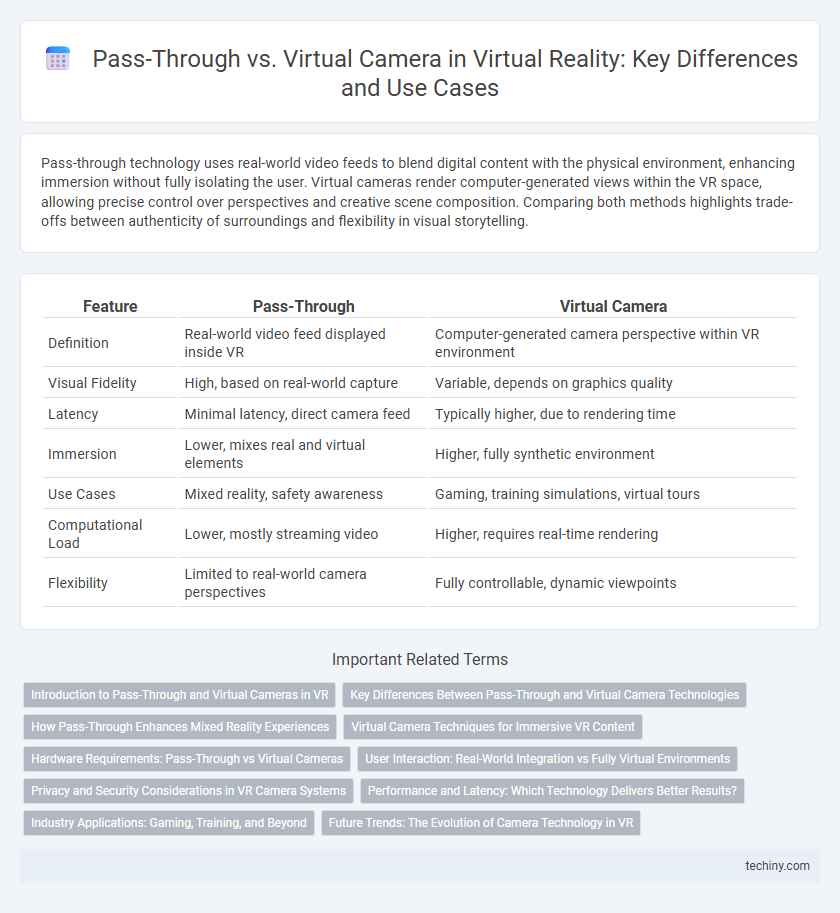Pass-through technology uses real-world video feeds to blend digital content with the physical environment, enhancing immersion without fully isolating the user. Virtual cameras render computer-generated views within the VR space, allowing precise control over perspectives and creative scene composition. Comparing both methods highlights trade-offs between authenticity of surroundings and flexibility in visual storytelling.
Table of Comparison
| Feature | Pass-Through | Virtual Camera |
|---|---|---|
| Definition | Real-world video feed displayed inside VR | Computer-generated camera perspective within VR environment |
| Visual Fidelity | High, based on real-world capture | Variable, depends on graphics quality |
| Latency | Minimal latency, direct camera feed | Typically higher, due to rendering time |
| Immersion | Lower, mixes real and virtual elements | Higher, fully synthetic environment |
| Use Cases | Mixed reality, safety awareness | Gaming, training simulations, virtual tours |
| Computational Load | Lower, mostly streaming video | Higher, requires real-time rendering |
| Flexibility | Limited to real-world camera perspectives | Fully controllable, dynamic viewpoints |
Introduction to Pass-Through and Virtual Cameras in VR
Pass-through technology in virtual reality uses external cameras to display the real environment inside the headset, enabling seamless integration between physical and virtual worlds without removing the device. Virtual cameras, on the other hand, simulate camera views entirely within the VR environment, allowing for dynamic perspectives and immersive scene rendering controlled by software. Both technologies enhance user experience by balancing realism and creative manipulation within VR applications.
Key Differences Between Pass-Through and Virtual Camera Technologies
Pass-through technology enables real-time video feed from external cameras, allowing users to see the physical environment while wearing VR headsets, whereas virtual cameras generate entirely computer-rendered scenes within the virtual space. Pass-through prioritizes environmental awareness and safety, integrating the real world with augmented elements, while virtual cameras focus on immersive experiences by creating dynamic, interactive digital environments. Key differences include latency, image quality, and use cases, with pass-through favoring practical mixed reality applications and virtual cameras excelling in fully synthetic, creative content production.
How Pass-Through Enhances Mixed Reality Experiences
Pass-through technology enhances mixed reality experiences by overlaying virtual objects onto real-world environments using real-time camera feeds, creating seamless interaction between physical and digital elements. Unlike virtual cameras that generate synthetic perspectives, pass-through maintains spatial accuracy and environmental context, improving user immersion and situational awareness. This real-world integration supports more intuitive navigation and natural engagement within mixed reality applications.
Virtual Camera Techniques for Immersive VR Content
Virtual camera techniques in immersive VR content leverage synthetic camera models to simulate realistic perspectives and dynamic movements, enhancing user presence and engagement beyond traditional pass-through displays. Unlike pass-through cameras that provide a direct, often lower fidelity view of the real environment, virtual cameras allow precise control over framing, depth of field, and parallax effects, critical for creating convincingly immersive experiences. Advanced algorithms for real-time rendering and spatial tracking integrate virtual cameras seamlessly with 3D environments, supporting interactive storytelling and complex scene compositions in VR applications.
Hardware Requirements: Pass-Through vs Virtual Cameras
Pass-through VR relies on external cameras integrated into the headset, requiring hardware with multiple high-resolution sensors and low-latency processing units to ensure real-time environmental capture. Virtual cameras operate within the VR software environment and demand robust GPU performance and advanced rendering capabilities to simulate realistic perspectives. While pass-through systems prioritize sensor quality and synchronization, virtual cameras emphasize graphical processing power and software optimization for seamless user experience.
User Interaction: Real-World Integration vs Fully Virtual Environments
Pass-through technology enhances user interaction by integrating real-world surroundings into virtual experiences, allowing natural hand gestures and spatial awareness to interact seamlessly with digital content. Virtual cameras offer fully immersive environments by replicating user perspectives within a completely computer-generated space, supporting complex virtual interactions without real-world visual input. The choice between pass-through and virtual camera impacts immersion, presence, and intuitive control in VR applications focused on user engagement.
Privacy and Security Considerations in VR Camera Systems
Pass-through in VR systems enables real-world visibility by using external cameras, raising concerns about unauthorized data capture and potential breaches of user privacy. Virtual cameras simulate real environments without recording actual surroundings, reducing risks associated with leaking sensitive visual information. Implementing robust encryption and strict data access controls is essential to safeguard user data in both pass-through and virtual camera configurations.
Performance and Latency: Which Technology Delivers Better Results?
Pass-through technology leverages real-time camera feeds to blend physical environments with virtual elements, often resulting in lower latency since it bypasses extensive rendering processes. Virtual cameras require fully rendered 3D scenes, which can increase processing load and introduce higher latency, potentially impacting user performance in VR applications. Consequently, pass-through tends to deliver faster response times and smoother interactions, making it preferable for scenarios demanding minimal delay.
Industry Applications: Gaming, Training, and Beyond
Pass-through technology enables immersive industry applications by overlaying digital elements onto real-world environments, enhancing training simulations and gaming experiences with real-time spatial awareness. Virtual cameras provide precise control over scene composition for virtual production and detailed training scenarios, allowing industries such as aerospace and healthcare to create realistic, interactive environments. Combining pass-through with virtual camera capabilities expands the scope of VR in sectors beyond gaming, including remote maintenance, architecture, and education.
Future Trends: The Evolution of Camera Technology in VR
Pass-through technology in VR enables real-time, high-fidelity integration of the physical environment with virtual content, enhancing spatial awareness and immersion. Virtual cameras, increasingly powered by AI and advanced algorithms, offer dynamic perspectives and adaptive rendering, transforming user interaction and narrative experiences. Future trends suggest a convergence of pass-through and virtual camera innovations, driving seamless mixed reality experiences with improved depth perception, reduced latency, and higher visual realism.
pass-through vs virtual camera Infographic

 techiny.com
techiny.com